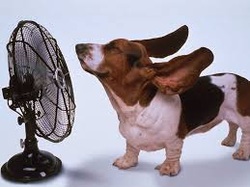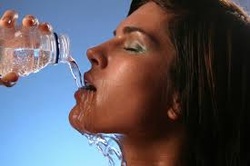 www.bubblews.com
www.bubblews.com I love higher temperatures. My younger years spent in Australia acclimatized my body to respond well to warm days. Besides that, here in England, my home is built on higher ground and remains relatively cool, shaded by trees and surrounded by sweeping fields.
Enjoy this relaxing music composed by Richard Maddock set against a background of little grebes making a nest on cool water while you read. Video by bellamoonnature.
Source: http://www.disastercenter.com/guide/heat.html
Heat can kill by pushing the human body beyond its limits. Under normal conditions, the body's internal thermostat produces perspiration that evaporates and cools the body. However, in extreme heat and high humidity, evaporation is slowed and the body must work extra hard to maintain a normal temperature. Elderly people, young children, and those who are sick or overweight are more likely to become victims of extreme heat. Because men sweat more than women, they are more susceptible to heat illness because they become more quickly dehydrated.
The duration of excessive heat plays an important role in how people are affected by a heat wave. Studies have shown that a significant rise in heat-related illnesses happens when excessive heat lasts more than two days. Spending at least two hours per day in air conditioning significantly cuts down on the number of heat-related illnesses.
People living in urban areas may be at greater risk from the effects of a prolonged heat wave than people living in rural regions. An increased health problem, especially for those with respiratory difficulties, can occur when stagnant atmospheric conditions trap pollutants in urban areas, thus adding unhealthy air to excessively hot temperatures. In addition, asphalt and concrete store heat longer and gradually releases heat at night, which produces significantly higher nighttime temperatures in urban areas known as the "urban heat island effect."
Watch for Signals
v Heat exhaustion: Cool, moist, pale, or flushed skin; heavy sweating; headache; nausea or vomiting; dizziness; and exhaustion. Body temperature may be normal, or is likely to be rising.
v Heat stroke: Hot, red skin; changes in consciousness; rapid, weak pulse; and rapid, shallow breathing. Body temperature can be very high -sometimes as high as 105 degrees F. If the person was sweating from heavy work or exercise, skin may be wet; otherwise, it will feel dry.
How to Treat a Heat Emergency
v Heat stroke: Heat stroke is a life-threatening situation. Help is needed fast. Call 9-1-1 or your local emergency number. Move the person to a cooler place. Quickly cool the body. Immerse victim in a cool bath, or wrap wet sheets around the body and fan it. Watch for signals of breathing problems. Keep the person lying down and continue to cool the body any way you can. If the victim refuses water, is vomiting, or there are changes in the level of consciousness, do not give anything to eat or drink.
v Heat cramps: Get the person to a cooler place and have him or her rest in a comfortable position. Lightly stretch the affected muscle and replenish fluids. Give a half glass of cool water every 15 minutes. Do not give liquids with alcohol or caffeine in them, as they can cause further dehydration, making conditions worse.
v Heat exhaustion: Get the person out of the heat and into a cooler place. Remove or loosen tight clothing and apply cool, wet cloths, such as towels or sheets. If the person is conscious, give cool water to drink. Make sure the person drinks slowly. Give a half glass of cool water every 15 minutes. Let the victim rest in a comfortable position, and watch carefully for changes in his or her condition.
 www.lifedynamix.com
www.lifedynamix.com Lean people tolerate heat better than obese people. The more obese a person is, the less skin surface area the person has in relation to their weight. Greater surface area provides more exposed skin to perspire and cool the body through evaporation. (This reminds me of an elephant's wrinkled skin, which must cool them.)
But this same fat can be beneficial to a person who lives in cold climates because the fat insulates skin tissue. The Inuit living in cold regions tend to have more body fat than people who live in warmer climates.
Humans are essentially tropical animals and are not equipped to deal with even mild cold. The only way we can live in cold climates is to wear appropriate clothing and to build shelters.
Successfully surviving cold requires two simultaneous events:
v generating sufficient body heat by burning appropriate food
v preventing the loss of that heat by suitable clothing and shelter.
Physiological responses such as shivering divert blood away from the extremities. The surface of the skin will then kick in. By this means, a reasonably well nourished adult can maintain their core temperature in still air just above freezing point wearing only light clothing.
The main advice seems to be to acclimatize to the outside temperature by ten degrees—either by heating or cooling the air inside. And keep a watch on elderly neighbors who live alone.
How do you cope with extremes of temperatures?

 RSS Feed
RSS Feed






